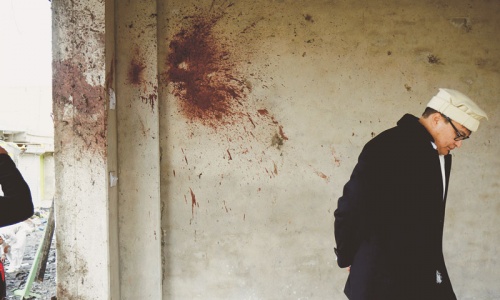Madeeha Syed speaks to Human Rights Watch's Ali Dayan Hasan about the state and predicament of the Hazara in Quetta
A year after the deadly attacks on the Hazara community, what is the situation now?
While Shias across Pakistan have faced increasingly vicious attacks, a disproportionate number of attacks - the latest being the Jan 21st attack on a pilgrim’s bus in Mastung - have targeted the small Hazara community. Of Shias killed across Pakistan in 2012, around a quarter of the victims were Quetta Hazaras. In 2013, a little under half of those killed were from that community. It is true that major attacks on the scale of January and February 2013 have not taken place since last year. But major attacks are only one aspect of the crisis faced by the community. Survivors and family members of victims describe the effects of a campaign of killings that has targeted all segments of the Hazara community. Hazaras live a ghetto existence, fearful of going about the normal business of life. Hazara religious pilgrims, students, shopkeepers, vegetable sellers, doctors and other professionals have been targeted leading to not just widespread fear but increasingly restricted movement leading to a ghettoisation of community members, increasing economic hardship and curtailed access to education.
How many are opting to flee their homes? And where are they going?
Large numbers are fleeing Pakistan in panic and seeking asylum abroad, even risking their lives in the process. Unable to cope with death stalking them at every turn, many hundreds have fled Quetta for Karachi or other parts of Pakistan. Yet further hundreds have fled Pakistan altogether. Those fleeing usually seek to go to Australia risking a dangerous sea journey that has repeatedly proved fatal. In April 2013, some 60 Hazaras died when their boat sunk in Indonesian waters enroute Australia. These journeys are not only dangerous and expensive, they are often deadly. Almost 1,000 people have died on the crossing from Indonesia to Australia over the last decade — scores of them Hazaras from Pakistan.
What is the Hazara's relationship with the Frontier Corps (FC) in Balochistan?
It is a complicated relationship. It would be correct to say that the Frontier Corps has done a better job in recent months of preventing the sorts of large-scale attacks we saw a year ago. And whatever reservations the Hazara community may have about elements of the FC, the fact remains that it is the lead security agency in Quetta.
But the problem remains that the FC is unable to disarm the Lashkar-i-Jhangvi (LJ) or meaningfully protect the Hazara from attacks. Further, it does not help that a small but significant body of opinion with Pakistan’s law enforcement agencies, paramilitary forces and intelligence agencies appear to view the Hazara with suspicion — as “agents of Iran” and “untrustworthy.”
And while there is no formal policy of tolerance for extremist elements such as the LJ at work, it is not possible to say yet with any certainty that there are no extremist sympathisers within lead law enforcement and security agencies. The matter is further complicated because elements from the security apparatus can be complicit in extremist attacks or turn a blind eye to them not out of conviction but also out of fear. But the fact remains that the FC has to be part of the solution.
There is a new government in Balochistan and more and more people have been raising their voice in support of the Hazara community. Has that brought about any changes at all?
While large-scale attacks have not taken place since the new Balochistan government took over in June, it remains the case that Pakistan’s federal government, the criminal justice system and the country’s military and its intelligence agencies continue to play the role of unconcerned bystanders as Shia across the country are slaughtered. Pakistan’s political leaders, law enforcement agencies, administrative authorities, judiciary and military need to prevent these attacks as they would any other threat to the state. Pakistan’s authorities must act urgently to end the state of deadly siege the Hazara and other Shia communities find themselves living under.
The Hazara are being killed not because they are party to a conflict but because they are helpless targets of murderous rage. They are killed not in combat but as they go about their daily lives — praying, selling and buying vegetables, boarding busses to go to work or college or travelling.
Of course, the Balochistan government has to be given both the benefit of the doubt and a fair chance. CM Malik is a highly respected figure. But equally, it remains true, as was the case with the previous provincial government, that the Balochistan provincial administration is only nominally responsible for security. That authority rests with the military through the FC and the intelligence agencies operating in the province. Unless these actors adopt a zero tolerance policy towards the LJ and other extremist actors, there is little the provincial government can do.
Has anyone to date ever been held accountable for any incidence of violence against the Hazara community?
There are sporadic crackdowns. Extremists are arrested. Some are even convicted. But often they are released without trial or conviction after a crisis has passed. Several high profile convicts have escaped from police and military custody in inexplicable circumstances in the past. The courts, even when they have been proactive in other areas such as disappearances, have been hesitant to provide protection to the Hazara or hold their attackers accountable. There has been no meaningful accountability.
Why are the Hazaras targeted specifically and so often?
Hazaras are generally unarmed, easily identifiable and utterly helpless — in short, easy to kill. Of course, they are being targeted as part of a broader exercise in targeting all Pakistani Shias but it is equally true that the Hazara suffer from double jeopardy — being ethnically distinct in addition to being Shia.
The author can be reached at @madeehasyed














































